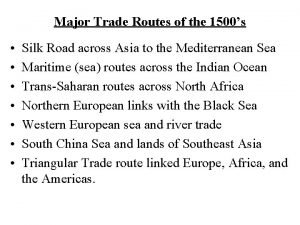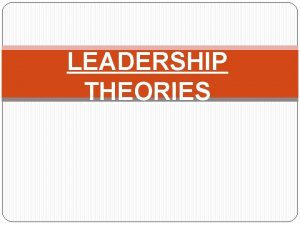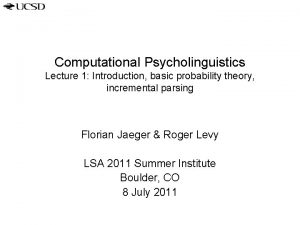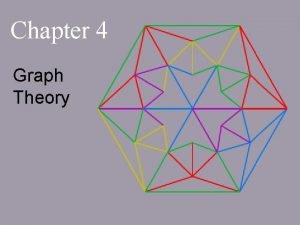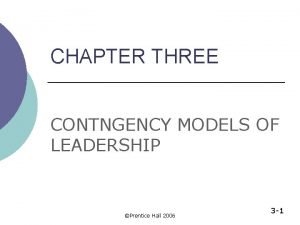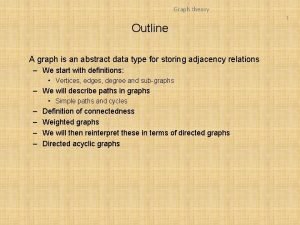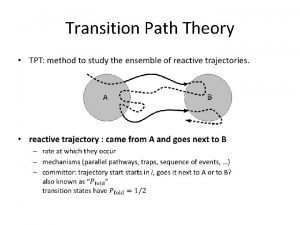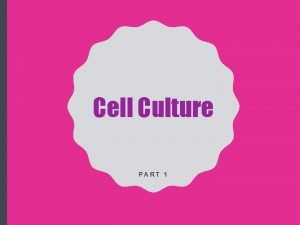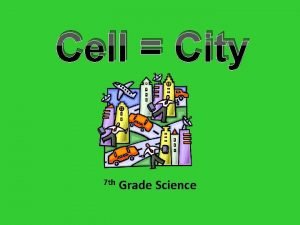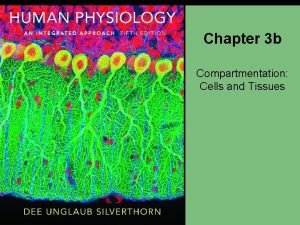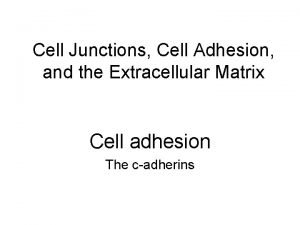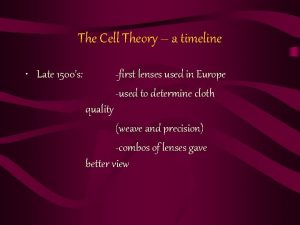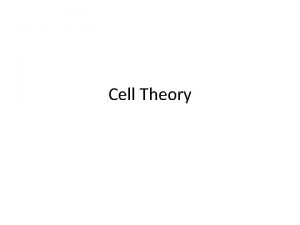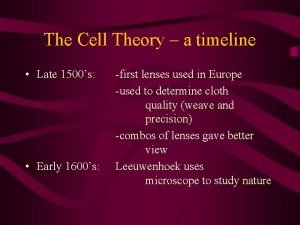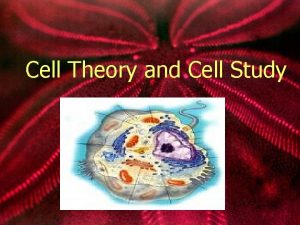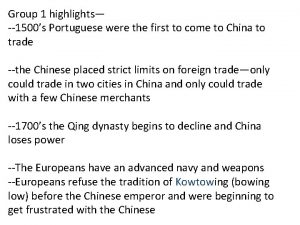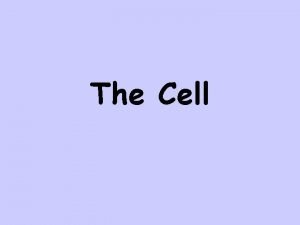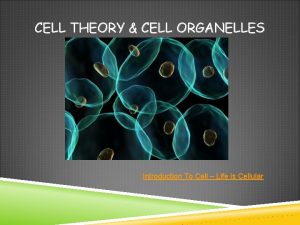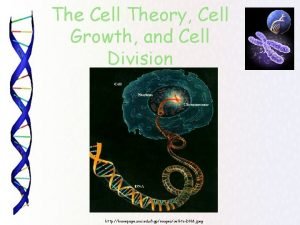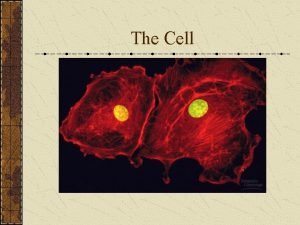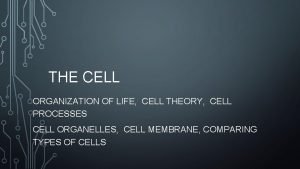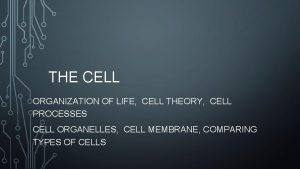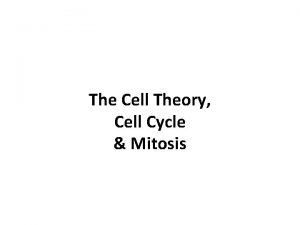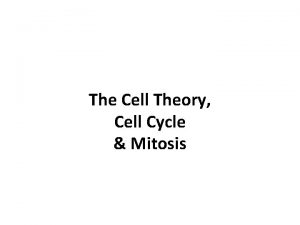The Path to the Cell Theory 1500s First











































































- Slides: 75

The Path to the Cell Theory 1500’s First magnifying lenses used in Europe to look at the quality of cloth 1600’s - First telescope and microscope constructed in Holland -

1665 Robert Hook – used a microscope to look at a thin slice of cork (bark from an oak tree) and saw what looked like small boxes - First to name them cells (because they looked like the small rooms that monks lived in called “cells”) Click on Leeuwenhoek 1674 Anton van Leeuwenhoek – First to view organisms using a microscope from pond water

Advancements in Cell Biology and Imaging Quality

Cofounders of the Cell Theory 1838 1858 Matthias Schleiden – concluded that all plants were made of cells Rudolf Vichow – Cells come from pre-existing cells. 1839 Theodore Schwann – concluded that animals were made of cells

The Cell Theory • All living things are composed of cells. • Cells are the basic units of structure and function in living things. • New cells are produced from existing cells.

Modern Cell Theory • With advancements and more studies in science the following additions have been added onto the Cell Theory: – Energy Flow occurs within cells. • Metabolism – Cells contain hereditary information that is passed on from cell to cell during cell division • DNA – All cells are basically the same in chemical composition in organisms of similar species.

Cell Types • Cells – Basic units that make up organisms – Can only be observed under a microscope – Three Basic Types: Animal Cell Plant Cell Bacterial Cell

Cell Sizes Plant cell > _______ Animal cell bacteria _____ > ______

CELL SIZE Typical cells range from 5 – 50 micrometers (microns) in diameter 9

How Big is a Micron ( µ ) ? 1 cm = 10, 000 microns 1” = 25, 000 microns 10

Number of Cells Although ALL living things are made of cells, organisms may be: • Unicellular – composed of one cell • Multicellular- composed of many cells that may organize into tissues, etc. 11

Multicellular Organisms • Cells in multicellular organisms often specialize (take on different shapes & functions) 12

Cell Specialization • Cells in a multi-cellular organism become specialized by turning different genes on and off • This is known as DIFFERENTIATION 13

Specialized Animal Cells Muscle cells Red blood cells Cheek cells 14

Specialized Plant cells Guard Cells Pollen Xylem cells 15

Biologists divide cells into two main categories: Eukaryotes

Prokaryotes • Simplest type of cell • Cells – Lack a nucleus or membrane bound organelles – Have single, circular chromosomes • Bacteria • Still carry out all life processes – grow, reproduce, move, respond to changes in their environments

Prokaryotes • Cell surrounded by cell membrane & cell wall • Nucleoid region (center) contains the DNA • Contain ribosomes (no membrane) in their cytoplasm to make proteins • Flagella – long tail like structure that aids in movement

Eukaryotes • More complex type of cells • Cells – Have a nucleus and membrane-bound organelles • Includes single cell and multi cellular organisms like protists, fungi, plants, and animals

Eukaryotic Cell Contain 3 basic cell structures: • Nucleus • Cell Membrane • Cytoplasm with organelles 20

Two Main Types of Eukaryotic Cells Plant Cell Animal Cell 21

Cell Organelles (Cell Structures) • Parts and Structures inside of the cell – Very small (microscopic) • Perform various and sometimes specialized functions for the cell • Found in the cytoplasm • May or may not be membrane bound

Animal Cell Organelles Ribosome (attached) Nucleolus Nuclear envelope Rough endoplasmic reticulum Golgi apparatus Ribosome (free) Cell Membrane Mitochondrion Smooth endoplasmic reticulum Centrioles 23

Plant Cell Organelles 24

Ribosome (attached) Nucleolus Nuclear envelope Rough endoplasmic reticulum Golgi apparatus Ribosome (free) Cell Membrane Mitochondrion Smooth endoplasmic reticulum Centrioles

Cell Membrane • Plasma Membrane • Function: – Surrounds the outside of all cells • Controls what enters and leaves the cell – Takes in food and water – Eliminates wastes – Protects and supports the cell Outside of cell Proteins Carbohydrate chains Cell membrane Inside of cell (cytoplasm) Protein channel Lipid bilayer

Cell Membrane • Made up of a phospholipid bilayer – Double layered sheet – Tough, flexible structure that forms a strong barrier between the cell and its surroundings Outside of cell Proteins Carbohydrate chains Cell membrane Inside of cell (cytoplasm) Protein channel Lipid bilayer

Cell Membrane • Heads (Made of gylcerol and phosphate) – Hydrophilic – Attract water – Point outward • Tails (Made of fatty acids) – Hydrophobic – Repel water – Point inward Outside of cell Proteins Carbohydrate chains Cell membrane Inside of cell (cytoplasm) Protein channel Lipid bilayer

The Cell Membrane is Fluid Molecules in cell membranes are constantly moving and changing 29

Cytoplasm Ribosome (attached) Nucleolus Nuclear envelope Rough endoplasmic reticulum Golgi apparatus Ribosome (free) Cell Membrane Mitochondrion Smooth endoplasmic reticulum Centrioles Cytoplasm

Nucleus Ribosome (attached) Nucleolus Nuclear envelope Rough endoplasmic reticulum Golgi apparatus Ribosome (free) Cell Membrane Mitochondrion Smooth endoplasmic reticulum Centrioles

Nucleus • Usually the largest organelle • Function: – Controls the normal activities of the cell

Nucleus • Function: – Contains DNA in chromosomes – Each cell has a fixed number of chromosomes that carry genes – Genes control the cell’s characteristics

DNA is the hereditary material of the cell. DNA contains the code and instructions to make different proteins. *Nucleus is found in eukaryotic cells. (All cells except bacteria).

Nuclear Envelope • aka Nuclear Membrane • A double membrane that surrounds the nucleus • Connected to the rough ER • Function: – Has pores that allow materials to enter and leave the nucleus Nuclear membrane or envelope is found in eukaryotic cells. (All cell except bacteria)

Nucleolus • Dense, round structure found inside nucleus -There may be more than one (plural nucleoli) -Disappears when cell divides • Function: -Makes building materials for ribosomes Found in eukaryotic cells. (All cell except bacteria)

Cytoskeleton Cell Membrane Endoplasmic Reticulum MICROTUBULES MICROFILAMENTS Ribosomes Mitochondrion

Types of Protein Fibers in Cytoskeleton • Microfilaments Made of actin protein found just inside C. M. to help to maintain cell shape and also to help cell to move. • Microtubules: Straight, hollow tubes made of globular protein, tubulin. Provide “tracks” for motor proteins to “walk” organelles. • Intermediate Filaments Reinforce cell shape and anchor organelles such as nucleus.

Cilia and Flagella • Made of protein tubes called microtubules • Function: – Move cells • Cilia – shorter and more of them on the cell • Flagella – longer and fewer of them on the cell • Found in various cells – (both prokaryotic & eukaryotic)

Cilia and Flagella Draw these pictures and label in your notes

Centrioles Ribosome (attached) Nucleolus Nuclear envelope Rough endoplasmic reticulum Golgi apparatus Ribosome (free) Cell Membrane Mitochondrion Smooth endoplasmic reticulum Centrioles

Centrioles (animal cells only) • Found only in animal cells • Made of bundles of microtubules • Appear during cell division and form the mitotic spindle • Function: Help to pull chromosome pairs apart to opposite ends of the cell

click image

Mitochondrion(found in eukaryotics cells) Ribosome (attached) Nucleolus Nuclear envelope Rough endoplasmic reticulum Golgi apparatus Ribosome (free) Cell Membrane Mitochondrion Smooth endoplasmic reticulum Centrioles

Mitochondria • Function: – Powerhouse of the cell – Cellular Respiration (burning of glucose) – Generates ATP (cellular energy) • In both plant and animal cells • The more active the cell (muscle cells) the more mitochondria they have

Mitochondria • Surrounded by a double membrane • Has its own DNA • Cristae - folded inner membrane (increases surface area for chemical reactions)

Endoplasmic Reticulum (found in eukaryotic cells) Ribosome (attached) Nucleolus Nuclear envelope Rough Endoplasmic Reticulum Golgi apparatus Ribosome (free) Cell Membrane Mitochondrion Smooth Endoplasmic Reticulum Centrioles

Endomembrane System Includes nuclear membrane connected to ER connected to cell membrane (transport) 49

Endoplasmic Reticulum (ER) • Network of hollow membrane tubules • Connects to nuclear envelope and cell membrane • Functions in synthesis of cell products and transport

Smooth Endoplasmic Reticulum • Does not have ribosomes on its surface • Attached to the end of the Rough ER • Function: – Makes cell products that are used inside of the cell • Membrane lipids (steriods) – Regulates calcium (muscle cells) – Destroys toxic substances (liver cells)

Rough Endoplasmic Reticulum • Has ribosomes on its surface • Function: – Ribosomes on the Rough ER make proteins for: • Cell Membrane • Export out of the cell – Proteins move to the inside the Rough ER and are modified and transported


Ribosomes (found in all cells) Ribosome (attached) Nucleolus Nuclear envelope Rough endoplasmic reticulum Golgi apparatus Ribosome (free) Cell Membrane Mitochondrion Smooth endoplasmic reticulum Centrioles

Ribosomes • Made of proteins and r. RNA • Can be free or attached to ER • Functions: – Protein Synthesis • Protein Factories - Make proteins for the cell • Join Amino Acids together to make proteins

Golgi Apparatus Ribosome (attached) Nucleolus Nuclear envelope Rough endoplasmic reticulum Golgi apparatus Ribosome (free) Cell Membrane Mitochondrion Smooth endoplasmic reticulum Centrioles

Golgi Apparatus • • Stacks of flattened sacs Looks like a stack of pancakes Has a shipping side and a receiving side Functions: – Modify, sort, and package molecules from the ER for storage or transport out of the cell

Golgi Apparatus 58

Golgi Animation Materials are transported from Rough ER to Golgi to the cell membrane by VESICLES 59

Lysosomes (animal cells)

Lysosomes • Contain digestive enzymes • Function: – Break down food, bacteria, and worn out cell parts for cells

Lysosome Digestion • Cells take in food by phagocytosis • Lysosomes digest the food & get rid of wastes 62

Click on image for video

Cell Wall (found in various cells but not animal)

Cell Wall • Surrounds the plant cell • Found outside of the cell membrane – Made of cellulose in plants – Made of peptidoglycan in bacteria – Made of chitin in Fungi • Function: – Supports and protects the cell

Vacuoles

Vacuoles • Fluid filled sacs • Function: – Storage of sugars, proteins, minerals, lipids, wastes, salts, water, enzymes, etc. • Large in plant cells • Small or absent in animal cells

Chloroplasts

Chloroplasts • Found only in plants – Specifically only in producers that have chlorophyll • Function: – Photosynthesis • Uses energy from the sun and makes own food (glucose) • Energy stored in the chemical bonds of sugar.

Chloroplasts • Contains its own DNA • Surrounded by a double membrane – Outer membrane smooth – Inner membrane has sacs called Thylakoids – Thylakoids in stacks call Grana • Interconnected – Stroma – gel like material surrounding thylakoids

Cell Membrane

Cell Membrane • Lies immediately against the cell wall in plant cells • Function: – Pushes out against the cell wall to maintain the cell shape

Factors Affecting Cell Size • Surface area (plasma membrane surface) is determined by multiplying length times width (L x W) • Volume of a cell is determined by multiplying length times width times height (L x W x H) • Therefore, Volume increases FASTER than the surface area 73

Cell Size • As cells increase in size the surface area to volume ratios decrease – Makes cells unable to obtain nutrients or remove wastes – Too big • Because of this cells divide to stay small or change shape to increase surface area or reduce volume

Cell Size Question: Are the cells in an elephant bigger, smaller, or about the same size as those in a mouse? 75

Cell Size Question: Are the cells in an elephant bigger, smaller, or about the same size as those in a mouse? About the same size, but … The elephant has MANY MORE cells than a mouse! 76
 Trade routes in the 1500s
Trade routes in the 1500s Trade routes 1500s
Trade routes 1500s Trade routes in the 1500s
Trade routes in the 1500s Chapter 4 cell theory and cell study
Chapter 4 cell theory and cell study Qimata
Qimata Spf shortest path first
Spf shortest path first House's path-goal theory
House's path-goal theory Garden path theory
Garden path theory Path goal theory of leadership
Path goal theory of leadership Michigan leadership studies
Michigan leadership studies Houses path goal theory
Houses path goal theory Elnaz delpisheh
Elnaz delpisheh Garden path theory
Garden path theory Path goal theory
Path goal theory Situational leadership youtube
Situational leadership youtube House path goal theory
House path goal theory Graph theory
Graph theory Revised path goal theory
Revised path goal theory Path graph theory
Path graph theory Pyemma tutorial
Pyemma tutorial Spongebob cell analogy
Spongebob cell analogy Denuding tower
Denuding tower Prokaryotic cell vs eukaryotic cell
Prokaryotic cell vs eukaryotic cell Prokaryotic
Prokaryotic Animal vs plant cell
Animal vs plant cell Cell reaction
Cell reaction Dry cell vs wet cell
Dry cell vs wet cell Animal cells and plant cells venn diagram
Animal cells and plant cells venn diagram Function of cells
Function of cells Plant cell structure
Plant cell structure What is the function of vacuole in the cell
What is the function of vacuole in the cell Cell wall vs cell membrane
Cell wall vs cell membrane Morphology of cells in culture
Morphology of cells in culture Cell line vs cell strain
Cell line vs cell strain Cell city project
Cell city project Primary source batteries
Primary source batteries Difference between plant and animal cell
Difference between plant and animal cell Cell-cell junction
Cell-cell junction Cell-cell junction
Cell-cell junction Which organelle prepares proteins for specific jobs
Which organelle prepares proteins for specific jobs Events of the cell cycle
Events of the cell cycle Prokaryotic cell and eukaryotic cell
Prokaryotic cell and eukaryotic cell Eukaryotic cell animal cell
Eukaryotic cell animal cell Cell organelles graphic organizer
Cell organelles graphic organizer Idealized plant cell
Idealized plant cell Walker cell and hadley cell
Walker cell and hadley cell Prokaryotes vs eukaryotes
Prokaryotes vs eukaryotes Cell cycle and cell division
Cell cycle and cell division Biology.arizona.edu/cell bio/activities/cell cycle/01.html
Biology.arizona.edu/cell bio/activities/cell cycle/01.html Phases of cell cycle
Phases of cell cycle Matlab string builder
Matlab string builder Voltaic vs electrolytic cell
Voltaic vs electrolytic cell Rigid outer covering of plant cells
Rigid outer covering of plant cells Hát kết hợp bộ gõ cơ thể
Hát kết hợp bộ gõ cơ thể Ng-html
Ng-html Bổ thể
Bổ thể Tỉ lệ cơ thể trẻ em
Tỉ lệ cơ thể trẻ em Chó sói
Chó sói Chụp phim tư thế worms-breton
Chụp phim tư thế worms-breton Alleluia hat len nguoi oi
Alleluia hat len nguoi oi Các môn thể thao bắt đầu bằng tiếng bóng
Các môn thể thao bắt đầu bằng tiếng bóng Thế nào là hệ số cao nhất
Thế nào là hệ số cao nhất Các châu lục và đại dương trên thế giới
Các châu lục và đại dương trên thế giới Công thức tính thế năng
Công thức tính thế năng Trời xanh đây là của chúng ta thể thơ
Trời xanh đây là của chúng ta thể thơ Mật thư tọa độ 5x5
Mật thư tọa độ 5x5 101012 bằng
101012 bằng độ dài liên kết
độ dài liên kết Các châu lục và đại dương trên thế giới
Các châu lục và đại dương trên thế giới Thơ thất ngôn tứ tuyệt đường luật
Thơ thất ngôn tứ tuyệt đường luật Quá trình desamine hóa có thể tạo ra
Quá trình desamine hóa có thể tạo ra Một số thể thơ truyền thống
Một số thể thơ truyền thống Cái miệng bé xinh thế chỉ nói điều hay thôi
Cái miệng bé xinh thế chỉ nói điều hay thôi Vẽ hình chiếu vuông góc của vật thể sau
Vẽ hình chiếu vuông góc của vật thể sau Nguyên nhân của sự mỏi cơ sinh 8
Nguyên nhân của sự mỏi cơ sinh 8 đặc điểm cơ thể của người tối cổ
đặc điểm cơ thể của người tối cổ

